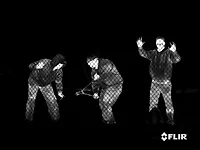The benefits of using K9 security in hospitals

Image via Freepik
Healthcare workers are exposed to violence more than any profession — to be exact, five times more likely to suffer a workplace violence injury than other workers.
Healthcare workers may experience or face verbal threats or physical attacks by patients, a distraught family member who may be abusive or even become an active shooter, gang violence in the emergency department, a domestic dispute that spills over into the workplace, or coworker bullying.
As a result, healthcare workers are at an increased risk for workplace violence. From 2002 to 2013, incidents of serious workplace violence (those requiring days off for the injured worker to recuperate) were four times more common in healthcare than in private industry on average, according to the Occupational Safety and Health Administration (OSHA).
In response, hospital security and safety leaders have started using protective dogs, or K9s, in combination with security best practices, to combat this rise in violence. Let’s explore some of the benefits of using protection dogs in hospitals and hospital emergency rooms.
K9 Security Use
Hospitals and patients are a vulnerable population, not only due to the challenges of their conditions and treatments but also due to the stress that hospitalization represents to patients and families.
For years, hospitals have used K9 units to deter and prevent crime and violence at facilities. At Pomona Valley Hospital Medical Center — a level II trauma hospital located in Los Angeles County — K9 units have patrolled the medical center for several years.
K9 Security Officer Marcus Brown, who has more than eight years of hospital experience and five years of experience as a K9 handler, says that K9 units can help prevent the use of force and de-escalate a potentially violent situation. Brown and his k9 partner, a stealthy male Belgian Malinois named “Enox,” are passionate about helping others in need and continue to be involved in training with other K9 teams in California.
“Mostly, it’s deterrence,” Brown says. As more hospitals and healthcare facilities look at non-lethal weapons to prevent the use of force to protect their officers, staff and visitors, k9s can be especially helpful. “Even security officers can get into use of force situations, but dogs can help prevent that.”
K9 units can work in any area of the hospital, from exterior locations to the emergency room, and are especially helpful in crowded areas. “I’ve used my dogs when we have large crowds, and then sometimes it escalates into a physical confrontation,” Officer Brown explains. “[However, when the] dog barks, it’s very aggressive and loud. And that puts people into shape.”
K9s can help de-escalate a violent situation and, in turn, help keep staff, visitors and security officers safe. During one particular incident, Brown recalls when a K9 helped to de-escalate a physical confrontation. “A gang-related shooting victim being treated. This was pre-COVID. There were about 30 to 50 family members who were fighting and blocking areas where we needed police personnel and fire and medical personnel to go in and out,” Brown explains.
In that situation, the K9 was used as deterrence and to help de-escalate the physical confrontation. “The dog barked a couple of times, and everyone ran. They just took off, which is what we wanted at that point. And then everyone was able to go back, and they were able to do their job.”
Officer Brown from Pomona Valley Hospital Medical Center explains that while there might be cons, the benefits outweigh them from his hospital’s perspective. “I applaud Pomona Valley Hospital Medical Center for recognizing the benefit to its patients and staff to invest in K9s,” he says.
Additional K9 Security Benefits
K9 units can also help hospitals recruit and retain doctors, nurses and staff, says Mike Dunning, an Executive Hospital Security consultant for K9 X-Factor and former Director of Security and Emergency Management for two healthcare systems and Level-1 Trauma Centers.
Dunning recalls helping a healthcare security team navigate the implementation of K9 units. “They were having trouble recruiting staff to come into their emergency department. So we suggested a canine unit, and [while] there was pushback, we found a team that really meshed with that healthcare team,” Dunning says.
Within a week, Dunning explains that there was a noticeable difference in the amount of violence that was occurring in and around the hospital itself, but particularly in the emergency department and the emergency waiting area. “The presence of that canine unit diminished that violence by upwards of 80%. Two years after, there’s a steady decline in the number of staff members quitting and an increase in the hospitals’ ability to hire and retain new staff," he says. "The staff satisfaction scores went up, and even the patient satisfaction scores started to increase because people weren’t afraid to be sitting in that emergency department.”
However, it may take time for people to become aware of the benefits of having protection dogs in hospital security details. Officer Brown explains, “When people see a [K9] walking around, they [may] ask, ‘Why do you have a dog in a hospital? Why do you have a police dog here? You guys are just security. Why do you need a dog?’” In this situation, it’s the officer’s responsibility to explain and educate the person. If the officer takes the time to do this, then “that negative turns into a positive.”
Looking for a reprint of this article?
From high-res PDFs to custom plaques, order your copy today!






